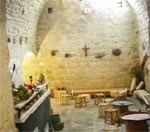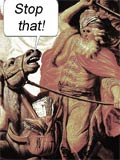A Surfeit of Jesuses! – But No "Jesus of Nazareth"
Was there a Jesus? Of course there was a Jesus – many!
The archetypal Jewish hero was Joshua (the successor of Moses) otherwise known as Yehoshua (Yeshua) bin Nun (‘Jesus of the fish’). Since the name Jesus (Yeshua or Yeshu in Hebrew, Iesous in Greek, source of the English spelling) originally was a title (meaning ‘saviour’, derived from ‘Yahweh Saves’) probably every band in the Jewish resistance had its own hero figure sporting this moniker, among others.
Josephus, the first century Jewish historian mentions no fewer than nineteen different Yeshuas/Jesii, about half of them contemporaries of the supposed Christ! In his Antiquities, of the twenty-eight high priests who held office from the reign of Herod the Great to the fall of the Temple, no fewer than four bore the name Jesus: Jesus ben Phiabi, Jesus ben Sec, Jesus ben Damneus and Jesus ben Gamaliel. Even Saint Paul makes reference to a rival magician, preaching ‘another Jesus’ (2 Corinthians 11,4). The surfeit of early Jesuses includes:
Jesus ben Sirach. This Jesus was reputedly the author of the Book of Sirach (aka ‘Ecclesiasticus, or the Wisdom of Jesus the Son of Sirach‘), part of Old Testament Apocrypha. Ben Sirach, writing in Greek about 180 BC, brought together Jewish ‘wisdom’ and Homeric-style heroes.
Jesus ben Pandira. A wonder-worker during the reign of Alexander Jannaeus (106-79 BC), one of the most ruthless of the Maccabean kings. Imprudently, this Jesus launched into a career of end-time prophecy and agitation which upset the king. He met his own premature end-time by being hung on a tree – and on the eve of a Passover. Scholars have speculated this Jesus founded the Essene sect.
Jesus ben Ananias. Beginning in 62AD, this Jesus had caused disquiet in Jerusalem with a non-stop doom-laden mantra of ‘Woe to the city’. He prophesied rather vaguely:
“A voice from the east, a voice from the west, a voice from the four winds, a voice against Jerusalem and the holy house, a voice against the bridegrooms and the brides, and a voice against the whole people.”
– Josephus, Wars 6.3.
Arrested and flogged by the Romans, Jesus ben Ananias was released as nothing more dangerous than a mad man. He died during the siege of Jerusalem from a rock hurled by a Roman catapult.
Jesus ben Saphat. In the insurrection of 68AD that wrought havoc in Galilee, this Jesus had led the rebels in Tiberias (“the leader of a seditious tumult of mariners and poor people” – Josephus, Life 12.66). When the city was about to fall to Vespasian’s legionaries he fled north to Tarichea on the Sea of Galilee.
Jesus ben Gamala. During 68/69 AD this Jesus was a leader of the ‘peace party’ in the civil war wrecking Judaea. From the walls of Jerusalem he had remonstrated with the besieging Idumeans (led by ‘James and John, sons of Susa’). It did him no good. When the Idumeans breached the walls he was put to death and his body thrown to the dogs and carrion birds.
Jesus ben Thebuth. A priest who, in the final capitulation of the upper city in 69AD, saved his own skin by surrendering the treasures of the Temple, which included two holy candlesticks, goblets of pure gold, sacred curtains and robes of the high priests. The booty figured prominently in the Triumph held for Vespasian and his son Titus.
Too strange to be a coincidence!
According to the Biblical account, Pilate offered the Jews the release of just one prisoner and the cursed race chose Barabbas rather than gentle Jesus.
But hold on a minute: in the original text studied by Origen (and in some recent ones) the chosen criminal was Jesus Barabbas – and Bar Abba in Aramaic means ‘Son of the Father’!
Are we to believe that Pilate had a Jesus, Son of God and a Jesus, Son of the Father in his prison at the same time??!!
Perhaps the truth is that a single executed criminal helped flesh out the whole fantastic fable.
Gospel writers, in scrambling details, used the Aramaic Barabbas knowing that few Latin or Greek speakers would know its meaning.
But was there a crucified Jesus?
Certainly. Jesus ben Stada was a Judean agitator who gave the Romans a headache in the early years of the second century. He met his end in the town of Lydda (twenty five miles from Jerusalem) at the hands of a Roman crucifixion crew. And given the scale that Roman retribution could reach – at the height of the siege of Jerusalem the Romans were crucifying upwards of five hundred captives a day before the city walls – dead heroes called Jesus would (quite literally) have been thick on the ground. Not one merits a full-stop in the great universal history.
But then with so many Jesuses could there not have been a Jesus of Nazareth?
The problem for this notion is that absolutely nothing at all corroborates the sacred biography and yet this ‘greatest story’ is peppered with numerous anachronisms, contradictions and absurdities. For example, at the time that Joseph and the pregnant Mary are said to have gone off to Bethlehem for a supposed Roman census, Galilee (unlike Judaea) was not a Roman province and therefore ma and pa would have had no reason to make the journey. Even if Galilee had been imperial territory, history knows of no ‘universal census’ ordered by Augustus (nor any other emperor) – and Roman taxes were based on property ownership not on a head count. Then again, we now know that Nazareth did not exist before the second century.
It is mentioned not at all in the Old Testament nor by Josephus, who waged war across the length and breadth of Galilee (a territory about the size of Greater London) and yet Josephus records the names of dozens of other towns. In fact most of the ‘Jesus-action’ takes place in towns of equally doubtful provenance, in hamlets so small only partisan Christians know of their existence (yet well attested pagan cities, with extant ruins, failed to make the Jesus itinerary).
What should alert us to wholesale fakery here is that practically all the events of Jesus’s supposed life appear in the lives of mythical figures of far more ancient origin. Whether we speak of miraculous birth, prodigious youth, miracles or wondrous healings – all such ‘signs’ had been ascribed to other gods, centuries before any Jewish holy man strolled about. Jesus’s supposed utterances and wisdom statements are equally common place, being variously drawn from Jewish scripture, neo-Platonic philosophy or commentaries made by Stoic and Cynic sages.

Nazareth – The Town that Theology Built

Babble
Mediaeval monks counted the repetitive chanting of ‘Our Fathers’ on pebbles or beads strung on a cord. Most knew no Latin and had no idea what they were saying.
Not a Prayer
”Still, despite the fact that the Lord’s Prayer must be a very early summary of themes and emphases from Jesus’ own lifetime, I do not think that such a coordinated prayer was ever taught by him to his followers.’
John D. Crossan, The Historical Jesus, p294.
Where Did They Get Their Ideas From?
The ‘Lord’s Prayer’? – No, just re-hashed Jewish litany
The New Testament is awash with prayers, hymns, and confessional statements. Tellingly, the early church did not attribute to its superhero the actual words of any of its prayers or hymns (something we might have expected of a great ‘Teacher’) … A sole exception appears to be ‘Our Father’ – but is it??
What becomes obvious is that the ‘Lord’s Prayer’ evolved along with the legend of ‘the Lord’ himself.
In the first four centuries of Christianity references to the ‘Lord’s Prayer’ actually are quite rare. Sure, it is to be found in Matthew chapter 6 and Luke chapter 11. But none of the Christian Apologists, for example, even mention it by name! Archaeology provides little evidence either: the ‘Bodmer XIV’ papyrus and another found in Antinoöpolis point to the 3rd or 4th centuries.
But a version of the prayer is to be found in a curious early second century document called the Didache. In this tract (aka Teaching of the Twelve Apostles) we find a familiar refrain (chapter 8.2):
‘Neither pray ye as the hypocrites, but as the Lord hath commanded in his gospel so pray ye: Our Father in heaven, hallowed be thy name. Thy kingdom come. Thy will be done as in heaven so on earth. Give us this day our daily bread. And forgive us our debt, as we also forgive our debtors. And lead us not into temptation, but deliver us from the evil: for thine is the power, and the glory, for ever.’
Proof positive? Not at all – we are talking of a document rejected by the Church in the 3rd century! The twelve apostles mentioned in the full title of the Didache are not twelve flesh and blood disciples of a Jesus but a reference to the twelve sons of Jacob representing the twelve tribes of Israel.
The Didache does not appear in any Bible because it is quasi-Jewish scripture!! According to this pre-gospel tract, “in the last days” it is “the Deceiver of the world” who is to appear as “the Son of God, and shall do signs and wonders “ not any divine carpenter (chapter 16.3,4)! The legend is still evolving. In the Didache there is no virgin birth, no ministry, no crucifixion. ‘Jesus’ gets 4 mentions, to be sure, but each time merely as the bringer of some knowledge of ‘the Lord’ (that is, God).
Older Jewish devotions provide even earlier antecedents for the prayer. One version of the Kaddish has it:
” May His great name be hallowed in the world which He created, according to His will, and may He establish His Kingdom … speedily and at a near time.”
The invocation ‘Father’ (Abinu or Abba) is common in Jewish liturgy (for example, in the 5th, and 6th benedictions of the Shemoneh ‘Esreh – the ’18 blessings’ – which according to tradition, were composed during the Second Temple period (6th century BC – 70 AD). In Hasidæan circles the invocation ‘Our Father who art in heaven’ was not unusual.
The first and principal part of the ‘Our Father’ is a prayer for the coming of the ‘kingdom of God’, exactly as in the Kaddish. In contrast, the primitive Christian community expressed ‘eschatological’ hope for the return of its hero – NOT the advent of the ‘kingdom.’ The ‘Our Father’ expresses nothing of the Christian belief that the Messiah had arrived in the person of Jesus.
” Give us our daily bread” is taken from Proverbs (30.8) composed between the 6th – 3rd century BC.
” Forgive thy neighbour if he hath hurt thee: and then shall thy sins be forgiven to thee” is taken from Ecclesiasticus (28.2) a 2nd century BC production.
There is no ‘Lord’s Prayer’ in Mark but ‘Mark’ (12.29-30) has ‘one of the scribes’ ask JC ‘which is the 1st commandment?’ and the godman gives a very Jewish answer:
“The first of all the commandments is, Hear, O Israel; The Lord our God is one Lord: (Mark 12 29)”
Building on this micro story, ‘Luke’ has JC responding to one of his disciples.The fellow had caught sight of Jesus praying (talking to himself if we believe in the Trinity!). ‘Teach us how to pray’ he asks. The response is the short version of the ‘Lord’s Prayer’ found in Luke.
‘Matthew’ re-worked Luke’s prayer into the longer version known to all.
In short, the godman’s prayer was derived from older Jewish sources.The ‘Our Father‘ – far from being unique, original or evidence of a godman – is nothing more than a handful of recycled Jewish invocations, composed into a pithy forma
Invisible Friend
‘Jesus of Nazareth’ supposedly lived in what is the most well-documented period of antiquity – the first century of the Christian era – yet not a single non-Christian source mentions the miracle worker from the sky. All references – including the notorious insertions in Josephus – stem from partisan Christian sources (and Josephus himself, much argued over, was not even born until after the supposed crucifixion). The horrendous truth is that the Christian Jesus was manufactured from plundered sources, re-purposed for the needs of the early Church.
It is not with a human being that the Jesus myth begins. Christ is not a deified man but a humanised god who happened to be given the name Yeshu. Those real Jesuses, those that lived and died within normal human parameters, may have left stories and legends behind, later cannibalised by Christian scribes as source material for their own hero, but it is not with any flesh and blood rebel/rabbi/wonder-worker that the story begins. Rather, its genesis is in theology itself.
CNN in the Garden of Gethsemane?
Is it unreasonable to ask just who recorded not only one of the last prayers of the godman but also the last occasion when the “living” superhero was with his acolytes? The only possible witnesses were asleep.
‘And he said, “Abba, Father, all things are possible unto thee; take away this cup from me: nevertheless not what I will, but what thou wilt.”
And he cometh, and findeth them sleeping, and saith unto Peter, “Simon, sleepest thou? Couldest not thou watch one hour?
Watch ye and pray, lest ye enter into temptation. The spirit truly is ready, but the flesh is weak.“
And again he went away, and prayed, and spake the same words.
And when he returned, he found them asleep again, (for their eyes were heavy,) neither wist they what to answer him.
And he cometh the third time, and saith unto them, “Sleep on now, and take your rest: it is enough, the hour is come; behold, the Son of man is betrayed into the hands of sinners.”– Mark 14.36,41 (Matthew’s version is almost identical, Luke has a shortened version and John omits the scene entirely.)
But of course as sacred theatre – a fabula praetexta – such paramulations back and forth and rhetorical declamations to an audience are precisely what we would expect.
Makes You Think
Many elements of the ‘Passion’ make no sense historically.
A trial for Jesus, when suspected rebels were habitually arrested and executed by the Romans without trial? Philo of Alexandria (On the embassy to Gaius, XXXVIII) speaks of Pilate’s ‘continual murders of people untried and uncondemned.’
And why would the Romans have allowed a convicted felon to be almost immediately removed from his cross and put in a tomb? Crucifixion was chosen precisely to make a public point that the most cruel and humiliating form of punishment awaits those who oppose Rome’s will. Roman disposition on this point was perhaps best summed up by Quintilian (AD 35-95, Decl. 274) when he wrote that:
“Whenever we crucify the guilty, the most crowded roads are chosen, where most people can see and be moved by this fear. For penalties relate not so much to retribution as to their exemplary effect.”
A century earlier, after the ‘slave revolt’ led by Spartacus, 6,000 prisoners were thus crucified along the Via Appia between the cities of Rome and Cappua, as a gruesome deterrent to further rebellion. Doubtless the corpses were left on their crosses to rot or to provide food for wild beasts and birds of prey.
But of course if the ‘Passion’ were really a pageant of a re-born sun-god it makes perfect sense that the ‘sacrificed’ actor be taken off-stage, subsequently reappearing in a later act, ‘reborn’…

Asclepius
Where Did They Get Their Ideas From?
Asclepius. Believed by the Greeks to have once lived as a man and raised to a god after death. He was fathered by a god – Apollo – but with a human mother (Coronis, a beautiful maiden of Thessaly). He was raised by the centaur Chiron in a cave and from him learned the art of healing. But Asclepius committed the unpardonable sin of raising a man from the dead, enraging Hades for cheating him of dead souls. Zeus, afraid that Asclepius might render all men immortal, slew him with a thunderbolt. Apollo interceded on behalf of his son and persuaded Zeus to make Asclepius the god of medicine. As an immortal, Asclepius was able to cure the sick from the realm of the gods.
Certainly, for centuries, sick people went to the temples dedicated to Asclepius hoping for a cure. It was said that those who came to Asclepius on crutches went away dancing happily. Famous temples of the god were at Pergamum, Epidaurus, Cos and Rome. Full participation in the healing program involved sleeping inside the temple compound – in effect, the first hospitals – where ‘holistic’ treatment involved massage, baths and dream interpretation. Fortunate individuals did indeed experience a “healing miracle” and gave testimony to the cure effected by this Greek god.
The early Christians attacked the cult of Asclepius with great venom, indicating a close rivalry between the two cults and a certain embarrassment among Christians repeatedly being told that Asclepius had already done all of Jesus’ tricks – and had done them better.
PS: High Priest John kills his brother “Jesus” in the Temple!
Yet another Jesus was slain – in the holy temple no less – during the reign of Artaxerxes I of Persia (circa 465-424 BC). His brother John, the High Priest, did the dirty deed. Writes Josephus:
“When Eliashib the High Priest was dead, his son Judas succeeded in the high priesthood; and when he was dead, his son John took that dignity …
Now Jesus was the brother of John, and was a friend of Bagoses, who had promised to procure him the High Priesthood. In confidence of whose support, Jesus quarreled with John in the Temple, and so provoked his brother, that in his anger his brother slew him.
Now it was a horrible thing for John, when he was High Priest, to perpetrate so great a crime, and so much the more horrible, that there never was so cruel and impious a thing done, neither by the Greeks nor Barbarians.
However, God did not neglect its punishment, but the people were on that very account enslaved, and the Temple was polluted by the Persians. … Accordingly, Bagoses made use of this pretense, and punished the Jews seven years for the murder of Jesus.”
– Josephus, Antiquities of the Jews – 11.7.
Sources:
Paul Johnson, A History of the Jews (Phoenix Grant, 1987)
John P. Meier, A Marginal Jew – Rethinking the Historical Jesus (Doubleday, 1991)
Josephus, The Jewish War (Penguin, 1959)
Leslie Houlden (Ed.), Judaism & Christianity (Routledge, 1988)
Riane Eisler, The Chalice & the Blade (Harper Collins, 1987)
Geza Vermes, The Changing Faces of Jesus (Allen Lane, 2000)
A. N. Wilson, Jesus (Harper Collins, 1993)
Ian Wilson, Jesus: the Evidence (Weidenfeld & Nicolson, 1984)
Alvar Ellegard, Jesus One Hundred Years Before Christ (Century, 1999)
Johannes Lehmann, The Jesus Report (Souvenir Press, 1972)
What’s in a Name?
The name Jesus is actually a 16th century creation.
“Jesus” has its origins in יהושוע (Yehoshua or Joshua) in which the first part “yeho” refers to God. The name means “YHWH helps”. But it was a name to be used with care and to prevent accidental voicing of the name of God, Yehoshua got truncated to ישוע (Y’shua), or, in the Galilee, to Yeshu.
Transliterated into Greek, Yeshu became Ἰησοῦς (Iesous), and from that, the Latin Iesus. A late development was the letter J which was then substituted for the initial capital I rendering Iesus into Jesus.
Artificial
‘The Jesus of the Gospels is an artificial creation, a collective work of art who evolved through the combined consciousness of two generations of Christian worship.’
– A. N. Wilson (Paul, p144)
No Evidence
”Whether Jesus ever actually existed has long been debated. The argument (very well documented) is that there is absolutely no corroborating evidence of his existence in documents other than highly suspect Christian sources.’
– Riane Eisler (The Chalice & the Blade, p122)
Chrestus?
“Christian defenders like to cite a passage in Suetonius that refers to someone named ‘Chrestus’ as a reference to their Savior; however, while some have speculated that there was a Roman man of that name at that time, the name ‘Chrestus’ or ‘Chrestos’ meaning ‘useful’ was frequently held by freed slaves.”
– Acharya S.
Not a Word
“There’s hardly a word of Jesus that is not to be found in a parallel saying of the rabbis.”
– Mark Tully (Lives of Jesus, p80)

Star Struck
As the Earth rotates, stars will appear to spin around the star most nearly in a direct line with the axis of the Earth’s rotation.
(In the northern hemisphere that’s the star Polaris. In the southern hemisphere a rough equivalent is the star Sigma Octantis.)
So, other than chasing off towards the pole, Messiah hunters – if they could keep up – would traipse around in a giant circle.
Better go for the comet theory…

‘Born under star’ from soothsayer with talking donkey!
And if you’ve ever wondered where the “born under a star” nonsense began it actually comes from the mouth of an Arab wizard supposedly hired to curse the Israelites.
“And Balaam said unto the ass, Because thou hast mocked me: I would there were a sword in mine hand, for now would I kill thee.
And the ass said unto Balaam, Am not I thine ass, upon which thou hast ridden ever since I was thine unto this day? was I ever wont to do so unto thee? And he said, Nay.”
– Numbers (22.29,30)
A little later Balaam utters the words wrenched out of context centuries later by Christian novelists:
“And Balaam said unto Balak … there shall come a Star out of Jacob.”
– Numbers (24.12,17)
Regarded as Fraudsters Even in the 2nd Century:
”Clearly the Christians have used … myths … in fabricating the story of Jesus’ birth’…
It is clear to me that the writings of the Christians are a lie and that your fables are not well-enough constructed to conceal this monstrous fiction.”
– Celsus (On The True Doctrine, c 178 AD)
Did the Rabbis Know Jesus?
The earliest rabbinic writings make no mention of the Christian godman.
Only when Christianity became a serious challenge to Judaism did the rabbis start to manufacture black propaganda of their own.
St Paul even had a friend called “Jesus”!
“My fellow prisoner Aristarchus sends you his greetings, as does Mark, the cousin of Barnabas … Jesus who is called Justus also sends greetings.
These are the only Jews among my fellow workers for the kingdom of God, and they have proved a comfort to me.”
– Colossians 4.10,11.
Last word
“I sought him but found him not.”
– Song of Solomon, 3.1.
- Would they lie? (Copy and Glorify!)
- The Apocryphal (and frequently revised) “Word of God”
- “Brother James”– Radical Jew Sanitized into Pious Christian Martyr
Now who could have been the brother of Jesus ben Damneus? - Jesus Christ – The Neighbour from Hell
- Missionaries or Murderers? – The Christianising of Europe
- 1000 Years of Carnage & Barbarity in the name of Christ
